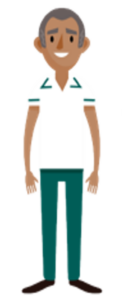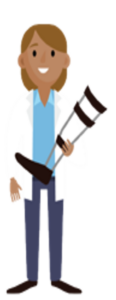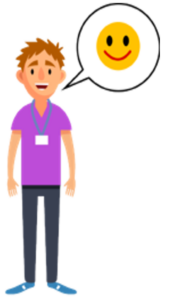There are 14 allied health professional (AHP) roles and they all have one thing in common – they play a vital part in treating, rehabilitating and improving the lives of patients.
AHP roles range from emergency response and radiography to podiatry and speech therapy, and with our world-class training and support, you’ll be able to make your role exactly what you want it to be.
If you are an allied health professional interested in returning to practice, you can learn more about the Kent and Medway Local Offer here.
We are the experts
As an AHP you’ll help patients in ways that few other healthcare professionals can – helping someone learn to walk again or fixing a child’s squint.
You’ll work alongside a multidisciplinary team of doctors and nurses, in a range of settings including hospitals and patient’s homes, as you help patients overcome obstacles, both mentally and physically.
AHP roles

Art, drama and music therapists use their chosen art form as a therapeutic intervention to help people with physical, mental, social and emotional difficulties.

Dietitians are skilled at translating scientific and medical research related to food and health into practical guidance for the public. You could, for example, work with people who have digestive problems, want to lose weight or need to put on weight after an illness, or people who have an eating disorder.

As an occupational therapist, you’ll help people who have difficulties carrying out day-to-day activities because of a disability, illness, trauma, ageing, or long-term conditions.

Operating department practitioners (ODPs) support patients during each phase of perioperative care, including:
- anaesthetic – provide care and prepare specialist equipment and drugs
- surgical – prepare equipment and instruments for operations and provide these to the surgical team during the operation
- recovery – supporting the patient throughout their time in the recovery ward, assessing vitals and fitness for return to the ward.
As well as providing this specialised care, ODPs are responsible for preparing the operating theatre and maintaining communication between the surgical team, operating theatre and wider hospital.
ODPs typically work in operating departments however their skills are increasingly being needed in other critical care areas within a hospital.

As an orthoptist, you’ll diagnose and treat eye movement disorders, as well as visual impairments related to the way the eyes interact with the brain. This means you’ll spot serious neurological conditions, such as multiple sclerosis and Parkinson’s disease.

You'll work as a self-employed primary care practitioner who is able to diagnosis and treat a wide range of health issues. You'll spend more time with patients than most professionals in primary care. There are also opportunities to work within the NHS and in secondary care.
You'll be an expert in the musculoskeletal system and its relationship to other systems of the body in the promotion of good health.
You'll provide care that includes a range of interventions, including:
- manual therapy techniques
- physical therapy (rehabilitation and exercise prescription)
- health advice
- self-management guidance.

As a physiotherapist, you’ll focus on identifying and maximising movement to improve the health and wellbeing of your patients.
Your role is vital in treating a variety of conditions such as:
- neurological (stroke, multiple sclerosis, Parkinson's disease)
- neuromusculoskeletal (back pain, whiplash associated disorder, sports injuries, arthritis)
- cardiovascular (chronic heart disease, rehabilitation after heart attack)
- respiratory (asthma, chronic obstructive pulmonary disease, cystic fibrosis)

Paramedics are the senior ambulance service healthcare professionals at an accident or a medical emergency. Paramedics are responsible for assessing the patient’s condition and then giving essential treatment. They use high-tech equipment such as defibrillators, spinal and traction splints and intravenous drips, as well as administering oxygen and drugs.
As a podiatrist, you’ll help people deal with a range of mobility issues, relieve pain and treat infections of the feet and lower legs. You’ll help with a variety of different issues, such as:
- children with lower limb pain or problems walking
- diabetes sufferers with circulation problems who may be at risk of amputation
- people with sports injuries and dancers whose long hours of rehearsing and performing put stress on their feet causing injury.

Prosthetists and orthotists have quite different roles but both aim to improve peoples’ ability to move freely. Prosthetists create and fit artificial replacements for patients who are missing a limb, while orthotists correct problems or deformities in nerves, muscles and bones with a range of aids.
The roles are quite varied and may include:
- fitting a prosthesis for a military veteran and seeing the full rehabilitation process
- giving a surgeon your advice when they’re performing an amputation
- helping all age groups, from children with cerebral palsy to adults with arthritis
- preventing a patient from needing an amputation through well-fitting splints and complex footwear.

Speech and language therapists provide life-changing treatment, support and care for children and adults who have difficulties with communication, eating, drinking and swallowing.
You'll help people who, for physical or psychological reasons, have problems speaking and communicating. Patients range from children whose speech is slow to develop, to older people whose ability to speak has been impaired by illness or injury. You’ll also treat those who have difficulty with eating or swallowing.

As a diagnostic radiographer, you’ll use cutting-edge technology to take images of the insides of patients to help understand and diagnose conditions. Based in a hospital, you’ll work with patients and colleagues to design treatment programmes and support patients until their treatment ends. From using a computerised tomography (CT) scanner to make a 3D image for a surgeon to preparing a patient for a magnetic resonance imaging (MRI) scan – you’ll be using some of the most complex and advanced technology. Diagnostic radiographers are also central to a wider multidisciplinary team, working and consulting with colleagues across various departments.
As a therapeutic radiographer, you’ll be part of a team helping people who are dealing with cancer. Based in a hospital, you’ll work with patients and colleagues to design treatment programmes and support patients until their treatment ends. From taking an initial x-ray, to using a CT scanner or a linear accelerator, you’ll use some of the most complex and advanced technology to treat tumours. Therapeutic radiographers are also central to a wider multidisciplinary team, working and consulting with colleagues across various departments.

